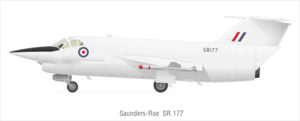Saunders-Roe SR.177 Video - Picture

|
|
Saunders-Roe SR.177

Picture - SR.177 with Red Top missiles
Role: mixed power interceptor
Manufacturer: Saunders-Roe
Number built: 0
Developed from: Saunders-Roe SR.53
The Saunders-Roe SR.177 was a 1950s project to develop a combined jet- and rocket-powered interceptor aircraft for the Royal Air Force and Royal Navy. The German Navy also expressed interest in the project, which was cancelled due to changes in Britain's military policies in 1957. A much larger development was studied under the SR.187 project for Operational Requirement F.155, but this work was also cancelled in 1957, after approximately 90% of the first prototype had been completed.
Design and development
In 1952, Saunders-Roe had won a contract to develop a similar aircraft, the Saunders-Roe SR.53. However, as development progressed, the shortcomings of the design became increasingly evident. Most particularly, as with the German rocket-powered interceptors of the Second World War, the range and endurance of such an aircraft were limited by the high rate of fuel consumption by the rocket engine. However, as turbojets developed and became increasingly powerful and efficient, soon new powerplants were available that would make the aircraft more practical.
The SR.177 began as an advanced design concept for the SR.53, but when a development contract was issued by the Ministry of Defence (specification F.155), the project was given its own designation.
The most significant difference between the two aircraft was the use of a jet engine with nearly five times the thrust of the one chosen for the earlier aircraft. This meant that while the SR.53 relied mostly on its rocket engine for climbing, the SR.177 would be able to add considerable endurance by conserving use of its rocket for the dash towards a target only. It was expected that the added endurance would allow the SR.177 to perform roles other than pure interception, and these were expected to include strike and reconnaissance. The SR.53 design was considerably enlarged to accommodate the new engine, and the original sleek lines were forfeited for a large, chin mounted intake to supply it with air.
Funding was secured in July 1956 for a total of 27 aircraft, and the first was expected to fly by April (later, October) 1958. However, 1957 was to see a massive re-thinking of air defence philosophy in the UK, outlined in the 1957 Defence White Paper which called for manned combat aircraft to be replaced by missiles. By the time that the programme was axed later that year, the aircraft had proceeded little past mock-up stage. In 1957 a development contract for the SR.177 was announced for its use with the Royal Navy.
Work on the aircraft continued a little longer, however, in the anticipation of continued interest from Germany. The British Ministry of Supply agreed to continue funding development of five of the six prototypes, but nothing was to come of it. The German government had changed its priorities from looking for an interceptor to a strike fighter, leading Saunders-Roe to redesign the aircraft for this role. This was followed immediately by another redesign when Rolls-Royce successfully convinced the German government to replace the de Havilland engine intended for the SR.177 with the Rolls-Royce RB.153. Even with Heinkel preparing to manufacture the aircraft locally under licence, Germany withdrew support in December 1957. The Minister had visited the German government in November 1957 as the Germans wanted the arrangements to be between governments instead of between their Government and Saunders-Roe.
Cancellation
Of the remaining aircraft under consideration the West German Government chose to purchase the Lockheed F-104 Starfighter instead to meet the role of "high-altitude reconnaissance machine, a tactical fighter-bomber, and an all-weather fighter", along with most of the European governments. This Lockheed coup, known as the "Deal of the Century", caused major political controversy in Europe and West German Minister of Defence Franz Josef Strauss was almost forced to resign over the issue. During later investigation into Lockheed's business practices it was discovered that Lockheed had paid out millions of dollars in "sales incentives" in each of these countries to secure the deal. Prince Bernhard of the Netherlands confessed to taking more than one million USD in bribes from Lockheed to buy the F-104.
With the withdrawal of German interest and no requirement for the SR.177 by the RAF, the existing Royal Navy requirement was considered not worth proceeding with and the Ministry of Supply cancelled the project. Saunders-Roe announced an expected 1,000 redundancies as a result.
Specifications
Data from
General characteristics
Crew: one
Length: 50 ft (15.2 m)
Wingspan: 30 ft (9.1 m)
Height: 14 ft (4.3 m)
Loaded weight: 25,500 lb (11,570 kg)
Powerplant:
1 x— de Havilland Gyron Junior turbojet, 8,000 lbf (35.6 kN)
1 x— de Havilland Spectre liquid fuel rocket, 8,000 lbf (35.6 kN)
Performance
Maximum speed: 1,550 mph (2,500 km/h) estimated
Service ceiling: 67,000 ft (20,500 m) estimated
Rate of climb: 60,000 ft/min (18,300 m/s) estimated
Armament
Missiles: 2 Firestreak air-to-air missiles
Avionics AI-23 airborne interception radar
Planes That Never Flew, Discovery Channel
Related development
SR.53
SR.182
Comparable aircraft
Nord 1500 Griffon
Republic XF-91 Thunderceptor
SNCASO Trident
Citations
Bibliography
London, Pete. "Saunders-Roe's Rocket Fighters." Aircraft, Vol. 43, no. 7, July 2010.
Mason, Francis K. The British Fighter since 1912. London: Putnam, 1992. ISBN 1-55750-082-7.
Winchester, Jim. "TSR.2." Concept Aircraft: Prototypes, X-Planes and Experimental Aircraft. Kent, UK: Grange Books plc., 2005. ISBN 1-84013-309-2.
Wood, Derek. Project Cancelled: The Disaster of Britain's Abandoned Aircraft Projects. London: Jane's, 2nd edition, 1986. ISBN 0-7106-0441-6.
Saunders-Roe SR.177 Pictures
More airplane videos.
Source: WikiPedia